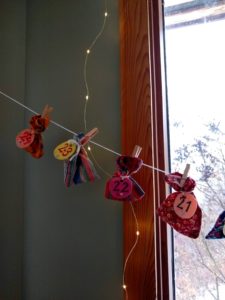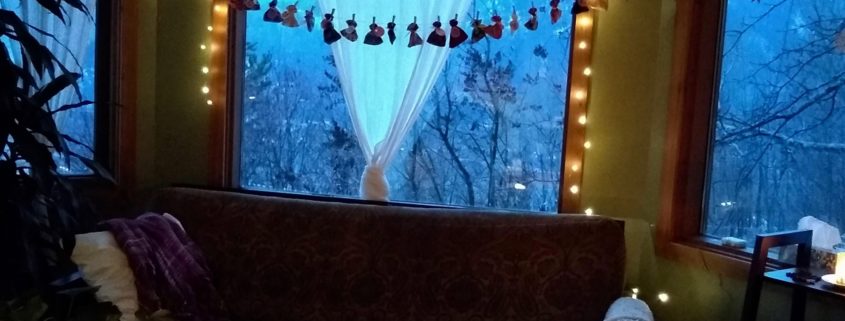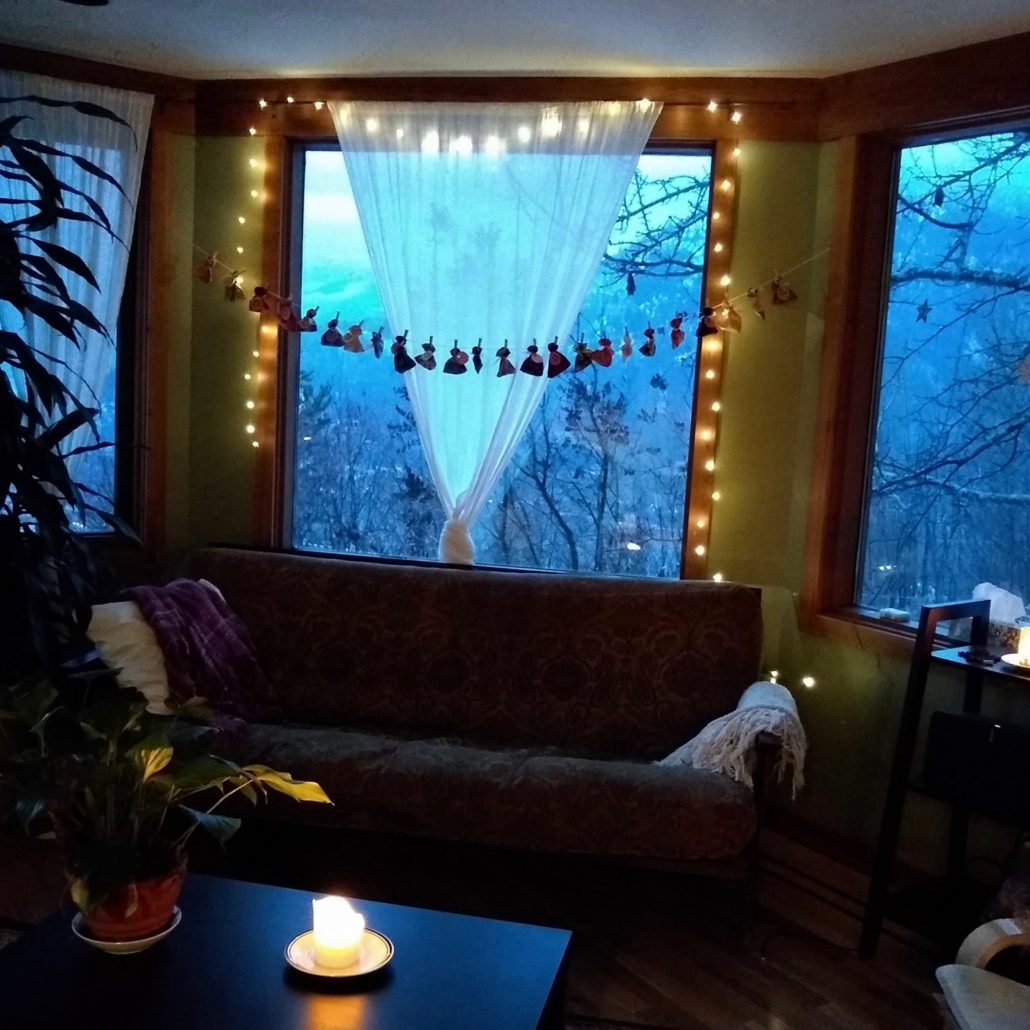Evolving Traditions — Keeping the Spark Alive
Once upon a time, when my daughter was a wee lassie, I spent a few evenings bent over the sewing machine, stitching together little bags from colourful scraps. Twenty-four bags to mark the journey of Advent for her, a cherished tradition from my childhood in Switzerland that I wanted to pass on. The bags were then filled with “pretty little things” as she would call them, and sometimes a treat (dried mango, chocolate, some nuts). Oh, how she loved this daily gift and preparation toward Christmas! It suited her 4-year old self quite perfectly.
A year later, our wee lassie had accumulated plenty of pretty little things, and really didn’t need a single more. But she loved the ritual of opening a bag a day during Advent and so we had a chat and she agreed that I could just find little items she already had — painted rocks, a bracelet, a little ornament, etc. lying around our home, tucked on her shelf, lost in a box — and repackage them in the Advent bags for her to open. That Advent she savoured what she already had.
The following year, listening for what might be a next step in this evolving tradition, we found that she, like so many children, delighted in looking for hidden things, and so we added this element, tucking the little bags under, behind and between our home furniture, and filling the 24 pouches with notes providing hints of where to look. I still remember the giggles erupting from her as she whizzed and whirled around the house looking for a hidden item.
This continued for a few years, until another step felt ripe: to share the bounty with others, as well as to expand from “little things and treats” to experiences. And so our tradition morphed into hiding a coin for each day, with clues to find them written on notes in each bag. She collected the coins and on Christmas Day would donate to a cause of her choosing. On the backside of the notes she would find experiences for each day, such as “bake cookies”, “read a story together”, “make snow angels”, “listen to music and make art”. She loved the continued inclusion of finding something, as well as marking the 24-day rhythm with quality times and then choosing where to gift the collected money. One year she bought five fruit trees for a village; another year she offered the coins to the local animal shelter.

I am curious to see how this tradition continues to evolve. For change it must, else such markings of time and meaning often get dropped or become stale. Traditions and rituals in my experience are here to bridge the subtle realm with the more tangible one. They ground us in what matters. They also bring comfort in a fast-moving time. We light candles to express that which cannot be fully contained in words: love, care, prayer, hope, grief. We gather together to honour the return of light at solstice in song, in circle, in stillness. We break bread. We bow down. We raise our hearts and voices. We walk in procession. There are so many forms we can give to catch and express a glimmer of the numinous and of the connection we share underneath all the separations and distinctions, but when the form takes over the content, the whole point is lost. This was made so clear to me in my days of going to school in a Benedictine Monastery and watching some of the monks perform rituals while yawning internally, form for the sake of form, content lost, empty shells that used to carry meaning.
So, let’s keep our eyes and hearts on the content, and remain attentive and curious to what form best serves it, rather than get tangled the other way around.
What are the evolving traditions of marking Solstice or Christmas or Hannukah or Advent or a Birthday or any other meaningful occasion amongst us humans, that include the depth of meaning possible, while staying light-touch with their ever-evolving forms?
Here a few pointers to keep this inquiry alive:
* When considering a form (ritual/tradition) to express the content of any meaningful occasion, ask yourself first: what is this occasion truly about for me, for us? Take time to consider, to contemplate. Go to the centre of what it is really about.
For example, when I reflect on Christmas and what it means for me, I find themes such as ‘humility and vulnerability’, ‘light in the darkness’, ‘the Divine embodied in the Christ child’, ‘stillness and emptying to receive anew, to refresh’, ‘an invitation to welcome and share Light through my life’, ‘family and connection with the larger community’. Perhaps you can distill even further to its main essence. For me that would be: Light.
* Once you have a sense of what the occasion carries as deeper meaning and intent, be creative: How might I/we bring form and symbol to express this theme? And how might we do this in ways that work for all involved (children and teens and grown-ups, varying cultures and traditions brought to the gathering, different types — fun-loving, serious, light-hearted, sincere, quiet, loud…)?
Our family gathers such themes, and then we find ritual(s) to express that, often very simple forms that change as the years go by, as we continue to grow and wake up. There have been years when we celebrated with a larger group and a few weeks beforehand asked each person how they would most like to mark the Christmas days, what had greatest meaning for them. Some of these forms included healing from traditions gone sour or turned empty in their past. The collection of forms we ended up stringing together like pearls on a necklace ranged from fasting to balance out the excess of food, playing games, sharing non-material gifts, feasting with food, prayer and song, to a walk in the snow and carolling in the neighborhood.
* Allow forms to evolve, while savouring and rejoicing in that which feels right to keep including (those traditions that work every time, until they don’t).
There are some forms that are timeless (so far!) in our family around this time of year: lighting candles in the snow with intention and prayer, ringing Christmas in with bells under the night sky at 4pm on Dec. 24th, Sarah McLaughlin’s Silent Night playing on repeat as we gather around the manger, sledding and cross-country skiing galore, handwriting Christmas cards, marking Advent in ways that help us slow down and in the words of my brother as a young lad “not get dizzy when Christmas comes around”. And then there are others that have come and gone. Staying connected to what feels real and right, and releasing the rest, provides both a solid sense of family culture, as well as a feeling of being held by our traditions instead of them pressuring or suffocating us.
* Keep it simple. When the intention is to find form that serves the content, a ‘container to hold the meal’, a ‘cup to hold the drink’, what counts most is the meal, the drink, the content. Just stopping and allowing a pause or a moment of quiet to fill a space can do the trick. Lighting a candle and speaking a wish/prayer out loud can bring a family closer. If it gets too complicated and especially if it gets rigid, you will lose people along the way. The form will become more important than the content.
I wish you forms — rituals and traditions — that are filled with meaning, that fill you up with the deeper layers of Life and Love. Then they are not a waste of time, or relics from times gone. Rather, they can give wings to the deepest yearnings we carry in our human hearts. Much love to you all this time of year when in our northern hemisphere the days are short, the nights long, and the invitation to pause, to ponder and to rekindle the fire in our midst is so very present.











Leave a Reply
Want to join the discussion?Feel free to contribute!